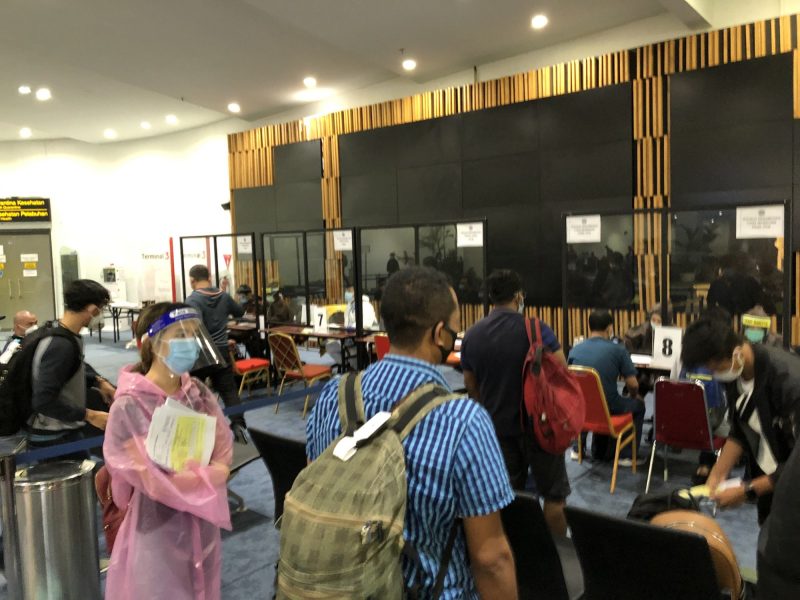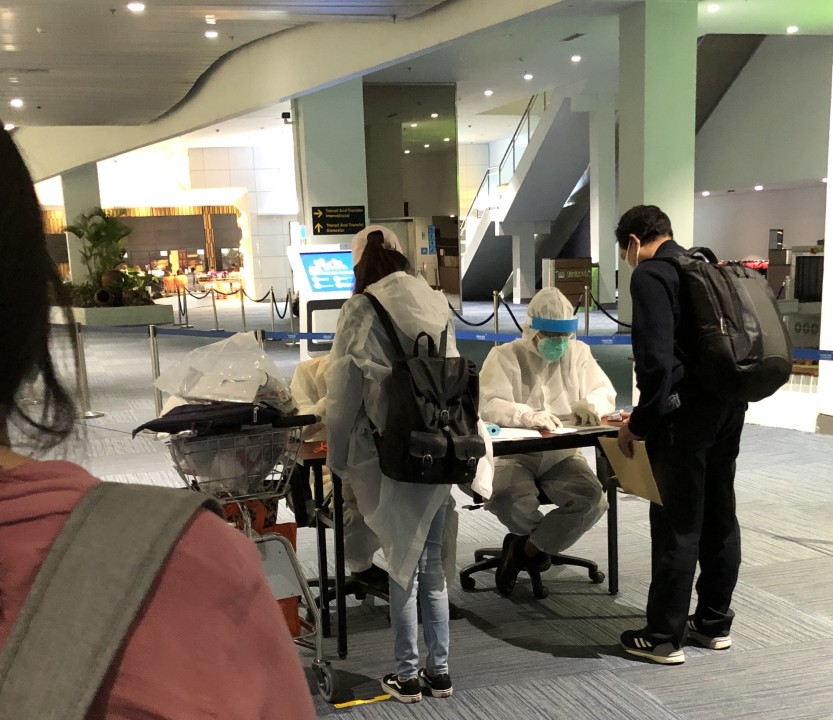Although I researched the new procedures and special requirements to enter Indonesia, I continued to be unsure on how it would actually work in practice. Hopefully, this explanation will be helpful for others traveling to Indonesia.
Like many foreigners based in Indonesia, I was traveling during the pandemic when the government made the decision to close its borders and limit entry to Indonesian citizens and foreigners holding work visas (KITAS). Currently only these two groups can enter and are required to possess at least a negative rapid test result and, at best, a negative PCR test result to enter the country.
After my business trip to Singapore was finished, I decided to return to Jakarta and needed to get a PCR test. As of 19 June, it remains very difficult to receive a PCR test in Singapore as they are rarely granted to those without symptoms. Contacting the special travel medical centers didn’t work either as they would only perform the test for government-approved travel to China as part of their new travel bubble. I was also refused by another doctor’s office when making an appointment for a PCR test many times. Travelers are allowed to fly to Indonesia (at least to the airport) with only a Rapid test result instead of a PCR test, but I don’t recommend this and will explain why later below.
How I was able to obtain my PCR test
Instead of making an appointment to get a PCR test, tell the doctor’s office that you need a “respiratory checkup” and do not mention anything about PCR and your request will be quickly accepted. Once you meet the doctor, then request a “fit to fly” letter that’s supported by a PCR negative test result. Also, show the doctor the Indonesian government’s requirement for international passengers entering the country. It’s crucial to remember that your PCR test result and doctor’s letter must be less than 7 days old when you enter Indonesia, otherwise, you be sent into a long, uncertain and risky government process to obtain a PCR test in Indonesia later. I recommended that you schedule the doctor’s visit first and then do the actual PCR test 2-3 days before you fly. The letter from the doctor should not be handwritten and needs the office/clinic stamp or “cap” stating that you have no respiratory ailments and should include the words “fit to fly” and also state your PCR test result is negative. You must also bring the PCR test result original hardcopy with you, photocopies aren’t accepted.
Check in at Changi
Singapore’s Terminal 3 at Changi airport was a ghost town with minimal flights operating. The terminal, for example, had only one flight and one airline counter operating. Check-in was easy and fast with Garuda, in this case. My visa, PCR test and doctor’s letter were all checked before I could check-in. Immigration was easy to pass through as the officers only examined my passport and visa, not the health documents. The terminal inside was almost completely empty with no passengers walking around and all the stores and shops were closed except for a Coffee Bean kiosk and a bubble tea stall. No other shops or restaurants were open.
The Flight to Jakarta
The flight was occupied less than half of its maximum capacity with the middle rows on both sides of the aisle intentionally left empty. There were several rows with no passengers around me. No hot meals or drinks served but a sandwich box and a bottle of water was handed out. Masks are required to be worn at all times and the aircrew wore masks, face shields and gloves throughout the flight. A Yellow Health Alert paper was handed out to every passenger to fill in name, passport details, address travel history, contact with any potential virus carriers and any Covid-19 related symptoms that you may have. The paper is in English and in Bahasa Indonesia.
Arrival at Soekarno Hatta
Once arriving at the gate at Terminal 3 Jakarta, there was no special announcement or instruction about the arrival process and health screening. We then disembarked but rather than entering the arrival section of the terminal, we were escorted to the departure level of the terminal and were told to “just wait” there. We waited for around one hour with no updates or information. Meanwhile, passengers on my flight wandered around the terminal and some mixed with other passengers that were awaiting the only other flight leaving Terminal 3 at that time which was at a gate nearby.
It turns out that the health screening section located at the lower level of the terminal was already full with over 200 passengers waiting to be checked and once they were cleared, we would be next. During the wait, many passengers were anxious and confused as to what was happening as there was no updates or anyone assigned to assist answer questions.
Health Screening Process
After about an hour wait upstairs, we were finally allowed to move downstairs to the health screening floor. There were at least one hundred or so passengers already waiting for siting in seats one meter apart in a very long queue. Our group was asked to stand behind them and wait with no other instructions were given. Some forms could be seen here and there but it remained unclear what they were for and if we needed them.
I asked other passengers ahead in the queue what the forms were and how to get them, but they didn’t know either. Finally, an air force soldier wandered by with some forms and said they were for passengers who have PCR test results. Later, another soldier made some type of announcement about forms but was inaudible since he was too far away, that sent many scrambling to try and get the form regardless of what it was for.
The sit-down queue soon became people just standing together with no physical distancing and quite confusing. I finally was able to speak to a worker at the front of the queue and was told that I needed to fill out a white “Health Clearance” (Klirens Kesehatan) form if I had a PCR test result. This is the form which will be used by the ministry of health port officer later in the process where they will check your temperature, pulse and oxygen level. This part of the process was the most stressful and confusing as passengers, including myself, were confused as to what forms were needed for those carrying rapid test result and those holding PCR test results and which “line” we should wait in as there were no one providing information or available to answer the passenger’s questions.
Eventually, through the confusion, I made my way to the front to a document check desk where they review your documents to see if they are complete. This line is mixed with those who have PCR test results and Rapid test people. We used the same pulse and oxygen finger meter, which was not cleaned after each use, so I highly recommend cleaning it yourself before and cleaning your hands after with your own sanitizer or hand wipes, as I didn’t see any provided.
The next part of the process involved two other document checks but this time by a ministry of health worker booth down the hall. At this point, there was little effort by passengers or staff to implement physical distancing and passengers were queuing as they would normally. Once the first check is complete, we moved to a second document check by a health worker and air force soldier who added various stamps. Once cleared there you are allowed to proceed to immigration where they also check your health documents. This immigration process was very quick and easy.
To summarize the health screening process:
- Step 1: Disembark and wait in departure level of the terminal before being moved to the lower level health screen area.
- Step 2: Preliminary document check once inside the health screening area.
- Step 3: Documents checked and approved by a ministry of health port officer.
- Step 4. Document confirmation check by air force soldier and ministry of health staff to ensure that your documents are complete and have been approved.
Your documents will be checked by another air force soldier one final time after baggage claim and before you exit terminal for keeping them handy.
Upon exiting the terminal, it’s very quiet and easy to get taxis such as Bluebird or your own transportation of choice.
In total, the health screening process for me took just over 2.5 hours which is quite long but understandable given the limited capacity of the booths/staff. The stressful part of the process was the lack of information and direction from airport and health staff during the entire part of the process along with the minimal physical distancing enforcement once we stepped off the plane.
The time it takes to go through the screening process is completely dependent on the number of passengers traveling at the time and I know of friends who have spent far less time at the health check screening.
Noticeably missing in my explanation above is what happens to individuals with only rapid test results. I highly recommend that you do not enter Indonesia with only a rapid test result.
The basic summary for those who only have a rapid test result upon arrival at Soekarno Hatta airport is:
- Fill in yellow Health Alert form.
- Queue with other passengers once disembark.
- Queue again once in the health screening area.
- Fill in a white document (Name unknown but different than the “Health Clearance” (Klirens Kesehatan) paper used for PCR holders).
- Pass preliminary document check desk.
- Proceed to queue for the ministry of health port officer “rapid test window”. There can be many passengers waiting here and little if any physical distancing is used.
- You will then be sent to a government appointed facility for 3-4 days quarantine until you receive a PCR test (unknown who pays for that). You can also book your own 3-4 days quarantine room at a government appointed hotel in Jakarta before your arrival. These hotels are designated for quarantine only and have very limited services and you must remain in your room.
- If your test comes back negative for Sars Cov-2 after your PCR test, you are allowed to go home for self-quarantine for 14 days. If the test comes back positive, you will then enter into a complicated process to be sent to Wisma Atlet, a government quarantine center which doesn’t have the best reputation according to some local doctors, so best to avoid the Rapid test process entirely and make sure you have a PCR test before you enter Indonesia.
The procedures to obtain PCR tests in Singapore and the entry process into Indonesia are likely to evolve so best to monitor the situation and keep yourself updated before you fly.
Hope everyone stays safe! : )
By Shawn Corrigan, an American who has grown interest into Indonesian politics ever since he was a student. Now, Shawn is a producer and podcast host of “Indonesia In-depth”, a podcast that aims to increase awareness and understanding of Indonesian politics and culture among the English-speaking curious minds. Aside from that, he is also a political risk consultant/legislative affairs liaison at LEXICO Indonesia for the past four years. With his great fascination with Indonesia, he is enriched with deep knowledge and experience to analyze Indonesian legislation, regulations, and the business landscape.




